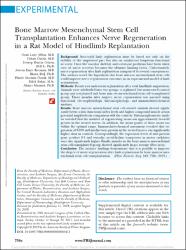Bone Marrow Mesenchymal Stem Cell Transplantation Enhances Nerve Regeneration in a Rat Model of Hindlimb Replantation

View/
Access
info:eu-repo/semantics/closedAccessDate
2019Author
Abbas, Ozan LuayOzatik, Orhan
Gonen, Zeynep Burcin
Kocman, Atacan Emre
Dag, Ilknur
Ozatik, Fikriye Yasemin
Bahar, Dilek
Metadata
Show full item recordAbstract
Background: Successful limb replantation must be based not only on the viability of the amputated part but also on satisfactory long-term functional recovery. Once the vascular, skeletal, and soft-tissue problems have been taken care of, nerve recovery becomes the ultimate limiting factor. Unfortunately, nerve regeneration after limb replantation is impaired by several consequences. The authors tested the hypothesis that bone marrow mesenchymal stem cells could improve nerve regeneration outcomes in an experimental model of limb replantation. Methods: Twenty rats underwent replantation after total hindlimb amputation. Animals were subdivided into two groups: a replanted but nontreated control group and a replanted and bone marrow mesenchymal stem cell-transplanted group. Three months after surgery, nerve regeneration was assessed using functional, electrophysiologic, histomorphologic, and immunohistochemical analyses. Results: Bone marrow mesenchymal stem cell-treated animals showed significantly better sciatic functional index levels and higher compound muscle action potential amplitudes in comparison with the controls. Histomorphometric analysis revealed that the number of regenerating axons was approximately two-fold greater in the treated nerves. In addition, the mean g-ratio of these axons was within the optimal range. Immunohistochemical assessment revealed that expression of S-100 and myelin basic protein in the treated nerves was significantly higher than in controls. Correspondingly, the expression levels of anti-protein gene product 9.5 and vesicular acetylcholine transporter in motor endplates were also significantly higher. Finally, muscles in the bone marrow mesenchymal stem cell-transplanted group showed significantly larger average fiber areas. Conclusion: The authors' findings demonstrate that it is possible to improve the degree of nerve regeneration after limb replantation by bone marrow mesenchymal stem cell transplantation.

















